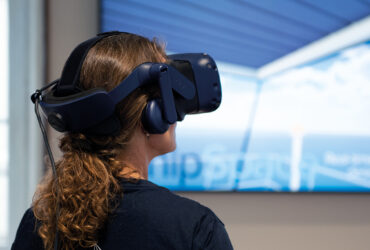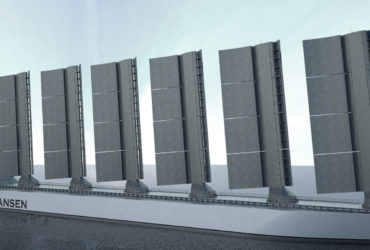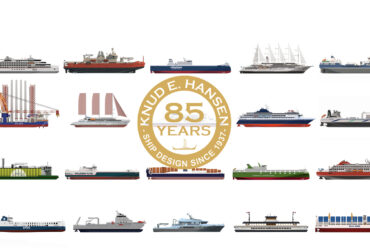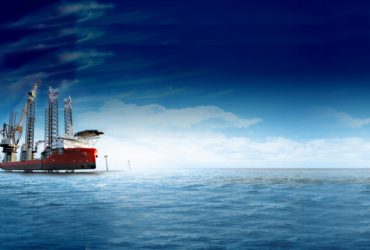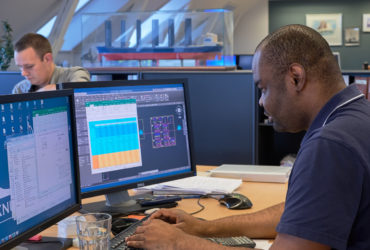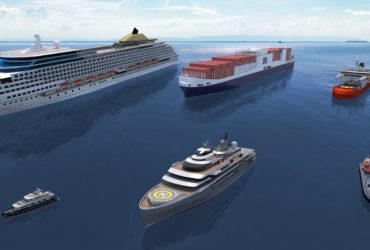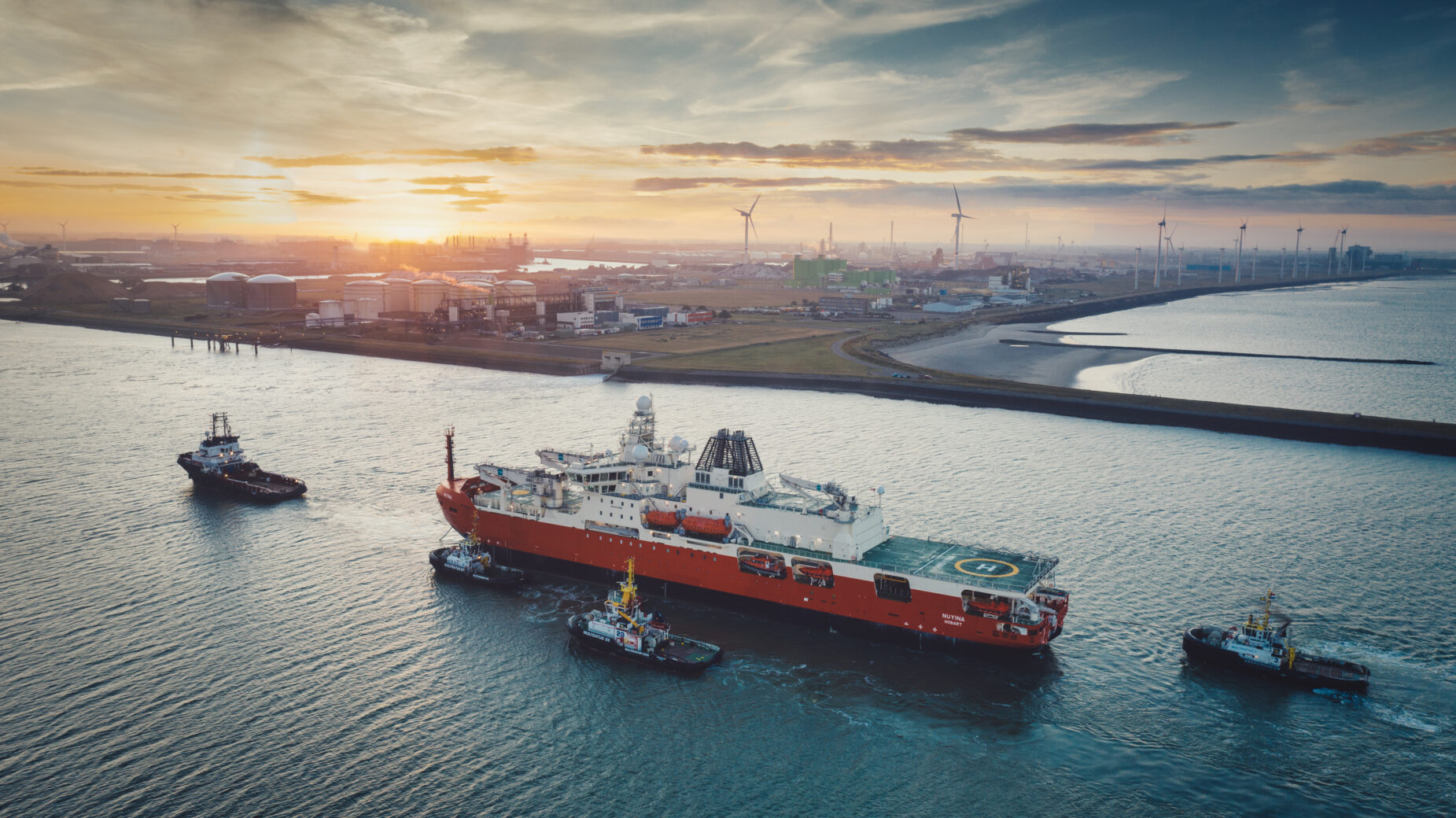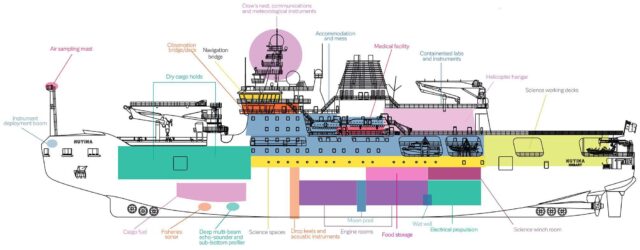Article
Introduction
While much has been said and written about the new polar ship Nuyina, and much more will be heard about her missions and achievements in the years to come, this paper aims to provide a brief insight to mark her first arrival in her home port. She arrived in Hobart, Tasmania on 16 October 2021 after a 47-day 12 958 n mile voyage from the historical fishing port of Vlissingen (Flushing in English) in the North Sea. Nuyina will be replacing the retired Aurora Australis which had served Australian Antarctic Division (AAD) for more than 30 years.
Her Naming
Her name was proposed by Australian schoolchildren through a ‘Name our Icebreaker’ competition. The word Nuyina, pronounced as “noy-yee-nah”, means ‘Southern Lights’ in palawa kani the language spoken by Tasmanian Aborigines. The name signifies the long connection that Tasmanian Aboriginal people have with the southern lights, or in other words with aurora australis.
Her Birth
The official delivery of the Australian Antarctic Division’s icebreaking Research and Supply Vessel (RSV) Nuyina took place three months earlier in the port of
Vlissingen on 28 August 2021. Her journey from design, to construction, and commissioning at Damen Schelde Naval Shipbuilding (DSNS) was not free from challenges and took more than five years, see Table 1. Not to mention the preceding five years of contemplation and planning at the government’s desk. Her naval architectural design was undertaken by Knud E. Hansen, a Danish-based leading independent consultancy with a portfolio of more than 800 ships built to their design since 1937.
She is designed to accommodate and deploy a wide range of vehicles from land, sea and air including helicopters, landing barges and amphibious trucks to support diverse operations. A unique feature to the vessel is her hybrid propulsion system which can support both the high power needed for icebreaking as well as the silent running for scientific operations. In terms of seakeeping she can handle:
• waves up to sea state 9 (14 m plus significant wave height)
• wind speed up to Beaufort 12 (hurricane)
• air temperatures ranging from −30° C to 45° C, and
• water temperatures ranging from −2° C to 32° C
While the construction of the hull and installation of machinery was successfully completed at Damen’s Galati shipyard in Romania, by mid-2020 the global outbreak of the COVID-19 pandemic was taking its toll on the progress of this project. At the outfitting stage, given the need to mobilise equipment suppliers and technicians from various parts of the world, to speed up the process it was decided to relocate her to Damen’s main shipyard site in Vlissingen the Netherlands.
Figure 1 Vlissingen is between two major EU ports
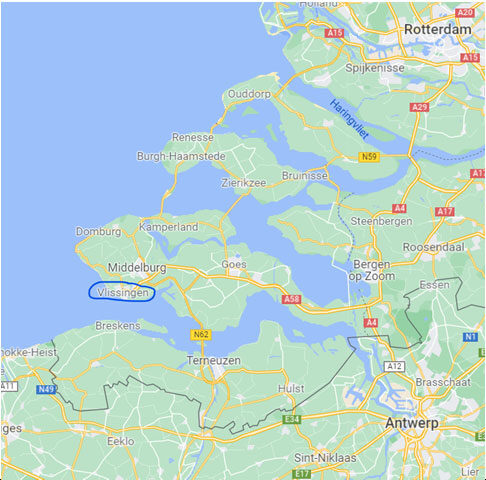
Vlissingen, due to proximity to two major European ports (Rotterdam at 130 km and Antwerp at 86 km), has a strategic and favourable position in this regard (see Figure 1). The 3672 n mile relocation journey, though a justified plan, its achievement was not easy as she had to pass many obstacles through the Black Sea, the Mediterranean and Strait of Gibraltar under tow. During towage through the Sulina channel on the Danube River in August 2020, her body lightly touched the ground. Consequently, on arrival in the Netherlands, she underwent thorough diver inspections followed by dry docking to ensure any scratch to the hull paint was identified and reinstated.
Monday morning 26 November 2020 was the moment of truth for her as she set sail for her first technical sea trials in the deep waters of the North Sea. More than 100 people, men and women including a medical doctor, accompanied her during this voyage. One prominent observation which caught the attention of those onboard was her silence and smoothness in various navigation and manoeuvring modes in comparison to other ships which they had experienced previously. Upon completion of three weeks of technical sea trials she headed towards Norwegian waters for the second part of trials to test and calibrate the scientific and environmental equipment capabilities. She returned to the Netherlands right before Christmas to recuperate and undergo further fine-tuning.
The push and need for delivery of Nuyina heightened as the news of a debilitating fire onboard MPV Everest broke out in April 2021. Such urgency demanded an intensified support and presence of the Australian team in the Netherlands. With the Australian government’s COVID lockdown measures in place the supervising team of AAD and SERCO crew visiting the Netherlands had to additionally bear the burden of quarantine on each flight returning home. Accordingly, a word of appreciation to their families and loved ones for their patience and support during this period is genuinely deserved.
Alongside the many players engaged in the battle with COVID restrictions, the Australian Maritime Safety Authority (AMSA) as the flag administration devoted
profound remote support to guarantee a timely delivery by holding frequent online meetings and review of progress reports. Finally, by 17 August 2021 Nuyina proved to be deserving of registration and the issue of the required certificates. Achieving this goal was an exciting moment of success for all parties including Lloyd’s Register (LR) as her classification society and certifying body on AMSA’s behalf. “I am sure that when Nuyina reaches her home it will be a very exciting and historical moment for the crew and the Australian nation. We wish Nuyina and her crew calm seas and decades of safe operation and important research work,” read part of LR CEO Nick Brown’s letter on this occasion. According to LR ship classification rules, Nuyina has earned a number of remarkable notations* as indicated in Table 2 which makes her an outstandingly prestigious ship in her own right.
Key dates and milestones
- Construction contract 28 Apr. 2016
- Steel cutting 31 May 2017
- Keel-laying 24 Aug.2017
- Launching 17 Sep.2018
- Harbour Acceptance Tests May 2019
- Classification 17 Aug.2021
- Arrival Hobart 16 Oct. 2021
Profile of Nuyina below showing the arrangement of facilities and equipment (Drawing courtesy Australian Antarctic Division)
Class notations
Classification |100A1 Research/Supply Ship, Icebreaker(+), Helideck, LA, *IWS, LI, Winterisation H(‐40), D(‐30), S(B), Ice Class PC3 Environmental ECO (BIO, BWT, EnMS, GW, IBTS, IHM, NOx‐2, OW, P, SEEMP, Sox) Machinery |LMC, CAC2, UMS, DP(AA), NAV1, IBS, PSMR*
Descriptive notes ShipRight [ES (anti heeling and anti roll tanks +1 mm for plating and internal stiffening), SCM, SERS]
As an example the PSMR* notation denotes that the main propulsion and steering systems are configured such that, in the event of a single failure in equipment, the ship will retain not less than 50 per cent of the installed prime mover capacity and not less than 50 per cent of the installed propulsion systems and retain steering capability.
Classification |100A1 Research/Supply Ship, Icebreaker(+), Helideck, LA, *IWS, LI, Winterisation H(‐40), D(‐30), S(B), Ice Class PC3
Environmental ECO (BIO, BWT, EnMS, GW, IBTS, IHM, NOx‐2, OW, P, SEEMP, Sox)
Machinery |LMC, CAC2, UMS, DP(AA), NAV1, IBS, PSMR*
Descriptive notes ShipRight [ES(anti heeling and anti roll tanks +1 mm for plating and internal stiffening), SCM, SERS]
The propulsion and steering arrangements are installed in separate compartments so that, in the event of the loss of one compartment, the ship will retain availability of propulsion power and manoeuvring capability. Nuyina’s propulsion system comprises diesel-driven main engines as well as electric motors and combinations thereof, all controlled through a smart Power Management System (PMS) for the various modes of sailing and icebreaking.
Figure 2 illustrates the redundancy in her propulsion arrangement — not to mention her steering and dynamic positioning capabilities featuring six thrusters and a pair of controllable pitch propellers. Figure 2 Propulsion layout (Drawing courtesy DSNS) If one wants to appreciate such a ship’s function and mission, the author recommends reading about Captain Shackleton’s crew and their ship Endurance. Nuyina, as a descendant of Endurance, is a unique investment and inspiring ship in many aspects. Her seakeeping, icebreaking, logistical and technical capabilities make her the right platform for future polar scientific explorations in the Antarctic. Assimilating and squeezing such diverse elements all within a 160 m body of steel posed many big challenges to the builder and
the owner. For instance, halfway through the design process it was realised that if she is to accommodate all the desired equipment then her mighty steel body needed to be further lengthened by almost 5 m! If one is interested to get a relative idea of Nuyina with respect to one of her age-sake relatives such as RRS Sir David Attenborough see Table 3. (Download full article in pdf below)
Table 3 — Main features of RSV Nuyina and RRS Sir David Attenborough (Wikipedia)

State-of-the-art Scientific Equipment
Nuyina will be the backbone of Australia’s Antarctic program over the next 30 years by providing a wide range of logistical and scientific exploration capabilities.
She will serve as the main lifeline to Australia’s three Antarctic research stations and its sub-Antarctic station on Macquarie Island. She has a number of flexible modular science laboratories and is the only ship in the world to have a watertight room or ‘wet well’ to process seawater for krill and other fragile marine organisms, at up to 1800 L per minute. Other scientific equipment includes acoustic instruments to map and visualise the seabed and organisms in the water column, and instruments to measure atmospheric gases, cloud properties, wave heights and ice conditions.
An overview of the scientific equipment and sensor suites is presented in Table 4. (Download full article in pdf below)
Table 4 — Overview of Scientific Equipment and Sensor Suite

Her Arrival and Future
As Nuyina emerged on the horizon in Hobart a COVIDlockdown in Tasmania held back her spectators at a distance and she showed her appreciation by blowing the whistle a number of times and making a magnificent 360° turn in the bay.
“We are excited to arrive in Hobart and finish the long voyage. Nuyina is a fantastic sea handling ship — very comfortable indeed. The voyage wasn’t without its challenges, as I’m sure you can imagine, but we had a brilliant and hardworking team of engineers on board who diligently worked through all the issues as hey presented themselves” Nuyina’s master Captain Gerry O’Doherty wrote on Sunday 17 October.2021.
“To the future crews and expeditioners aboard Nuyina, you carry with you the discoveries of the past, the questions of today and the dreams of the future. I wish you calm seas and clear skies,” said Scott Morrison, the Prime Minister.
The author, in the capacity of a classification society surveyor who has witnessed Nuyina’s performance during her sea trials in the North Sea, wishes to comment that “We learnt and continue to learn many great lessons through this journey that the spectacular Nuyina is taking us from Romania to the Netherlands and then Australia and soon to the Antarctic polar waters for the many years to come.
Such a story of hardship and success could not unfold without the vision of the Australian nation as the investors in the first place and, secondly, the ‘borderless’ support, innovation and knowledge sharing among the industries from many countries. I feel honoured for myself and LR in being part of this great journey as the scientific findings through Nuyina will benefit the inhabitants of this planet in securing a more sustainable future.”
Currently due to COVID-19 restrictions public access onboard is limited. Nuyina stays in Hobart until December for further commissioning and preparations before taking up her first Antarctic mission. Nuyina’s many stories and adventures are to be continued.
Nuyina arriving in her home port of Hobart (Photo courtesy Australian Antarctic Division)
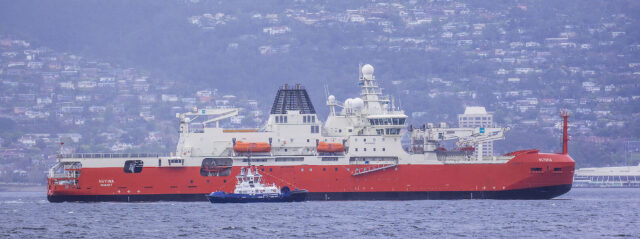
Acknowledgment
The author wishes to thank all those who supported and continue to contribute to Nuyina in various capacities. Special appreciation is reserved to Daniel Webster Electrical Engineering Manager, Serco Defence, for sharing and permission to publish pictures and material.
References:
To learn more about the meaning and character of the classification abbreviations reference is made to Lloyds Register rules and regulations Part 1 Section 2 available for download at: https://www.lr.org/en/rules-and-regulationsfor-the-classification-of-ships/Video and article published on 16 October 2021 at: https://www.antarctica.gov.au/nuyina/stories/2021/antarcticicebreaker-arrives-in-hobart/
Download article
Related news
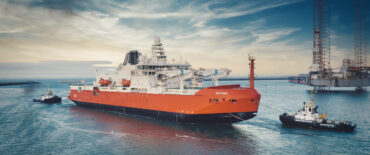
ARSV Icebreaker Antarctic Supply and Research Vessel
- Vessel type: Arctic
- Vessel name: Nuyina
- Project number: 13006
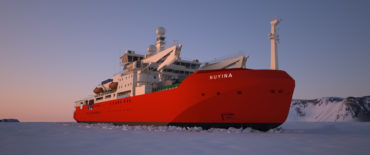
Naming of ARSV vessel Nuyina
Read more
Birth of an Icebreaker
Read more
Giant Icebreaker arriving in Netherlands for final fit-out
Read more
Ship superstructure on the rise
Read more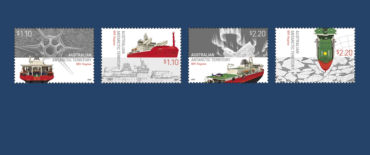
Artist impressions for stamps by KNUD E. HANSEN
Read moreImages

















